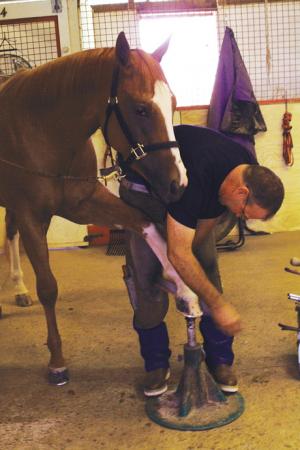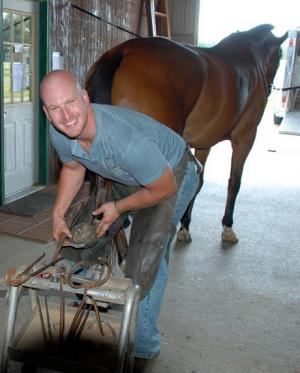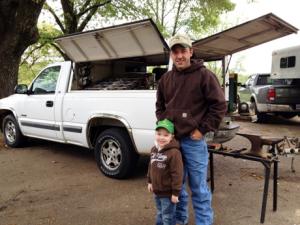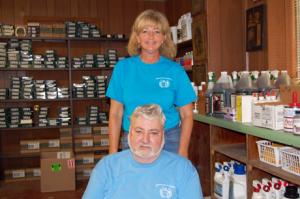By MSHR staff
The 15th annual National Farrier’s Week is July 7-13, 2013. In support of these dedicated and hard-working individuals, the Mid-South Horse Review focuses on farriers and hoof care in July. This year the MSHR staff asked several mid-south area farriers questions regarding their training, experience, and specializations based on breed or discipline. They also gave advice on common hoof problems, their solutions, recommended products, and what horse owners can be doing to keep horses’ hooves in shape. We regret that we could not interview all the farriers in the area, but here is a sampling of farriers’ responses (in alphabetical order):
Charles Beavers has been a farrier for 26 years, picking up the trade from his grandfather. He works primarily with barrel horses and flat shod trail horses. He also commonly works with laminitic and foundered horses. He rides and exercises his client's horses to get them back to a healthy weight so they can overcome their laminitis. He says the most important thing for owners is to stay on a steady trimming or shoeing schedule: every 6 weeks in the summer and every 8 weeks in the winter. The grass causes hooves to grow faster in the summer, and foundered hooves grow up to 4 times faster than normal. He sticks to traditional remedies such as Turpentine for abscesses, grease as a conditioner and powdered milk to strengthen hooves by adding calcium. Beavers also recommends Lim Couch, whom he consults for especially tough cases.
Daniel Bishop has been a farrier for 16 years. He received his training at the Eastern School of Farrier Science. He trims and shoes Hunters and Jumpers. He specializes in correct shoeing and therapeutic shoeing. Some problems he sees are laminitis and founder. Therapeutic shoeing can help these problems. Bishop recommends that horse owners include a good hoof oil and a sealant to keep moisture in and dew out. He recommends Essol, Hoof Shield and Lamina Saver.
Josh Burchfield has been shoeing since he was about 13 years old, also taught first by his grandfather. He then learned during various apprenticeships with several established farriers. He works on gaited horses, particularly speed racking, and doesn't see many problems with the hooves he works on. For shoeing, Burchfield works with the horse's physiology. For upkeep, Burchfield recommends keeping up with regular farrier work. He says horses should stay on a 6 weeks schedule. He doesn't recommend any particular products but he says basic hoof moisturizers and basic hoof supplements are good to use. Good care and good nutrition are key to good hooves. Burchfield says how horses are cared for and fed comes out in their hair and hooves.
Rowdy Childress has been shoeing for about 8 years full-time, but on and off since he was 18 years old. His training consisted of learning from other farriers. He works with Quarter horses, barrel horses, and roping horses. To determine how to shoe the horse, he looks at what the horse is used for and what the horse needs for that job. Laminitis is a common problem. To work with laminitis, he makes sure he, the client and the vet are all working together. Most are grass founder, so they get them off grass and in a stall with thick shavings, on a special diet and with proper hoof care. In the heat, hooves can become dry. Childress recommends using a hoof conditioner to fix dry hooves.
Dean Cook has been shoeing since childhood, and is working on a Master’s Degree in farrier science. He works mainly with Quarter horses, including trail, cutting, and reining horses. Cook says that owners should spend time picking up their horses feet regularly, and they should pick the horses feet clean at least once a week. Owners can help the farrier by having horses ready and waiting so that farriers can stay on their schedule of appointments. It is also good for horse owners to be present at the time of shoeing or hoof trims. Good horse behavior and knowing how to stand tied are also helpful to farriers.
Lim and Mary Ann Couch. Lim Couch is renowned for his horseshoeing school and has taught over 1700 students over the decades. He graduated from North Texas Horseshoeing Institute in Grapevine, TX on November 18, 1966. He became an apprentice farrier, a certified farrier and then a journeyman farrier July 9, 1983. He was president of the American Farrier’s Association, has been inducted in the Hall of Fame, and had numerous honors over his career. Lim may be “retired” from horse shoeing, but he is still available to advise and educate. Two products for hoof care that Mary Ann Couch recommends are Spurr’s Big Fix, supplements like Kaeco’s Biotin 800Z, and Hoof Flex by Absorbine. On the first day of National Farriers Week, July 7, Lim will be 75 years old. The Mid-South Horse Review wishes Lim a Happy Birthday!
James Denton has been a farrier for 36 years, thirty of them part-time and full time for the past six years. “My dad taught me about shoeing horses. I continue to research and read a lot about it and attend the Farrier’s Summit in Cincinnati, OH every year to keep learning as much as I can.” He shoes a lot of Quarter horses for barrel racers and pleasure riding as well as gaited horses for trail riders and a few thoroughbreds for hunter/jumpers and dressage. Almost 99% of his work is cold shoeing. Common problems are seedy toe, thrush, founders, and especial long toe low heel syndrome. Denton said that there is a lot of the latter in the area from lack of attention as well as genetics. “Quarter horses need to be up on their toe. Many will not grow enough heel to get them on their toes and they will need wedges.” He works with veterinarian Dr. Lee Butler of the Huntington Animal Clinic. He said horse owners should be doing regular hoof care. A lot of the problems are from lack of attention. He recommends Right Step for topical hoof care and Farrier's Formula if a dietary hoof supplement is needed. Both products are manufactured by Life Data Labs.
Garry Edgin has been a farrier for 30 years. He got his education by apprenticing with other established farriers. He works mainly with AQHA show horses, for classes such as Pleasure, Hunter under Saddle, and Halter. He shoes according to the class the horse is competing in. “When you do AQHA, each class is a different way to shoe. The way the horse is shod changes it’s movement, so I do what is best for each class,” Edgin said. “I don’t have many hoof problems at all with show horses. The most I really see is a little thrush.” Edgin recommends Durasole for the thrush and Spurr’s Big Fix to moisturize and kill bacteria in the whole hoof. For owners, Edgin said that keeping a horse’s hooves clean is the best way to keep thrush away and keep hooves in good shape. “The best thing owners can do is to keep a horse’s hooves clean, and pick them out regularly, especially in shod horses. The shoes keep in manure and dirt that builds bacteria,” he said. He recommends Horse Shoer’s Secret and Farrier’s Formula to help with hoof growth and strength.
Harold Elder is a graduate of the Mid-South Horse Shoers Academy and has been a farrier for about 40 years. His clients are hunters and jumpers, carriage horses, field trail and trail horses, as well as Quarter Horses. He emphasizes, “People should not forget the importance of regular maintenance trims. A common problem is that horses’ feet can be either too wet or too dry. When the season changes and the dry season is here, the owner should use hoof oil two to four times a week. But, this can be difficult when the horse is being boarded and is not on the customer’s property. Any oil based product is good when the hoof is dry. Harold recommends Biotin 800Z made by Kaeco and Hoof Power by Delta.
Joe Hillman has been a farrier for 42 years. His training began when The University of Tennessee offered an introductory course taught by Lim Couch, who later opened his own school. He works with a range of horses, including Arabian endurance, gaited and backyard horses. He assesses each horse and does what needs to be done for that particular horse's needs. Some common problems he sees are dry, chipped hooves, especially in the summer. He frequently sees abscesses. Hillman suggests that horse owners find a farrier they like and stick with him. He recommends Farrier's Formula, a supplement with Biotin in it. It has improved the hooves of 7 out of 10 horses he has used it on.
James Luttrell graduated from the North Texas Horseshoeing Institute in Grapevine, TN in 1970. He works mainly on dressage horse, hunter/jumpers, and welsh ponies. He also works for several veterinarians. He shoes horses based on their needs. “You have to look at the horse and assess what it needs. Make the horse comfortable and don’t interfere with its way of going. Consult with the trainer, learn what the horse’s job is, and shoe/trim according to needs. I also do a lot of corrective shoeing. Luttrell advises owners to form a good working relationship with veterinarians for the best care. James believes that good nutrition is the main key to good hooves. He recommends Farrier’s Formula.
Josh Pounders has been a farrier since 1998. He started working for Jack Scott, and then studied under Greg Speltz. Pounders does all types of horse classes, as well as backyard horses, all primarily Quarter horses. He bases the shoeing on individual horse’s needs. A common problem is dry, brittle hooves. Pounders recommends using hoof dressing about two times a week. He also recommends regular trimmings, basing the timing on the individual horse’s growth and discipline. Pounders said to stick with the same farrier – “one you trust. Some problems take time to solve, so work with your farrier toward long-term goals for your horse.” He uses Hooflex, and recommends Biotin for horses that need it.
Stacy Steward is one of the relatively small number of female farriers in the country. Stacy is a 2007 graduate of Oklahoma State Horseshoeing School, and she works with veteran farrier Harold Elder. “I really learned a lot from Harold. There are things you can’t learn in school, but you can learn from the older generation of shoers. He’s done a wonderful job training me on many things.” Stacy shoes hunters/jumpers, carriage horses, and Quarter Horses. “A good balanced diet is usually sufficient for a healthy hoof, which varies from horse to horse depending on how much work they are doing. Every horse’s diet should be based on high quality forage. The weather and the condition of the stalls will dictate whether the hoof needs an oil product or a sealer. I recommend Keratex. It helps seal the hoof, which is necessary since horses are turned out so much in this area.”
Mark Taylor has been a farrier since 2003. He is certified by the Association for the Advancement of Natural Horse Care Practices and through Liberated Horsemanship of St. Louis and Warrenton, MS. Taylor trims all types of horses using natural hoof care. “We use the wild Mustang hoof as a model and simulate it in the trim. The hoof is not flat, but has deep concavity. You don’t have to pick them out so much, and the self-cleaning also helps avoid thrush and other issues.” Common problems include abscesses and white line disease, as well as hooves that chip and break. A solution to help minimize these issues is beveling the edge around the hoof wall. Regular hoof care and trimming is important, as well as attention to nutrition. “In our area, pastures are generally low in copper, magnesium, and zinc.” For horses lacking these minerals, Taylor recommends a hoof supplement by Source: Focus HF and biotin.
The 15th annual National Farrier’s Week is July 7-13, 2013. In support of these dedicated and hard-working individuals, the Mid-South Horse Review focuses on farriers and hoof care in July. This year the MSHR staff asked several mid-south area farriers questions regarding their training, experience, and specializations based on breed or discipline. They also gave advice on common hoof problems, their solutions, recommended products, and what horse owners can be doing to keep horses’ hooves in shape. We regret that we could not interview all the farriers in the area, but here is a sampling of farriers’ responses (in alphabetical order):
Charles Beavers has been a farrier for 26 years, picking up the trade from his grandfather. He works primarily with barrel horses and flat shod trail horses. He also commonly works with laminitic and foundered horses. He rides and exercises his client's horses to get them back to a healthy weight so they can overcome their laminitis. He says the most important thing for owners is to stay on a steady trimming or shoeing schedule: every 6 weeks in the summer and every 8 weeks in the winter. The grass causes hooves to grow faster in the summer, and foundered hooves grow up to 4 times faster than normal. He sticks to traditional remedies such as Turpentine for abscesses, grease as a conditioner and powdered milk to strengthen hooves by adding calcium. Beavers also recommends Lim Couch, whom he consults for especially tough cases.
Daniel Bishop has been a farrier for 16 years. He received his training at the Eastern School of Farrier Science. He trims and shoes Hunters and Jumpers. He specializes in correct shoeing and therapeutic shoeing. Some problems he sees are laminitis and founder. Therapeutic shoeing can help these problems. Bishop recommends that horse owners include a good hoof oil and a sealant to keep moisture in and dew out. He recommends Essol, Hoof Shield and Lamina Saver.
Josh Burchfield has been shoeing since he was about 13 years old, also taught first by his grandfather. He then learned during various apprenticeships with several established farriers. He works on gaited horses, particularly speed racking, and doesn't see many problems with the hooves he works on. For shoeing, Burchfield works with the horse's physiology. For upkeep, Burchfield recommends keeping up with regular farrier work. He says horses should stay on a 6 weeks schedule. He doesn't recommend any particular products but he says basic hoof moisturizers and basic hoof supplements are good to use. Good care and good nutrition are key to good hooves. Burchfield says how horses are cared for and fed comes out in their hair and hooves.
Rowdy Childress has been shoeing for about 8 years full-time, but on and off since he was 18 years old. His training consisted of learning from other farriers. He works with Quarter horses, barrel horses, and roping horses. To determine how to shoe the horse, he looks at what the horse is used for and what the horse needs for that job. Laminitis is a common problem. To work with laminitis, he makes sure he, the client and the vet are all working together. Most are grass founder, so they get them off grass and in a stall with thick shavings, on a special diet and with proper hoof care. In the heat, hooves can become dry. Childress recommends using a hoof conditioner to fix dry hooves.
Dean Cook has been shoeing since childhood, and is working on a Master’s Degree in farrier science. He works mainly with Quarter horses, including trail, cutting, and reining horses. Cook says that owners should spend time picking up their horses feet regularly, and they should pick the horses feet clean at least once a week. Owners can help the farrier by having horses ready and waiting so that farriers can stay on their schedule of appointments. It is also good for horse owners to be present at the time of shoeing or hoof trims. Good horse behavior and knowing how to stand tied are also helpful to farriers.
Lim and Mary Ann Couch. Lim Couch is renowned for his horseshoeing school and has taught over 1700 students over the decades. He graduated from North Texas Horseshoeing Institute in Grapevine, TX on November 18, 1966. He became an apprentice farrier, a certified farrier and then a journeyman farrier July 9, 1983. He was president of the American Farrier’s Association, has been inducted in the Hall of Fame, and had numerous honors over his career. Lim may be “retired” from horse shoeing, but he is still available to advise and educate. Two products for hoof care that Mary Ann Couch recommends are Spurr’s Big Fix, supplements like Kaeco’s Biotin 800Z, and Hoof Flex by Absorbine. On the first day of National Farriers Week, July 7, Lim will be 75 years old. The Mid-South Horse Review wishes Lim a Happy Birthday!
James Denton has been a farrier for 36 years, thirty of them part-time and full time for the past six years. “My dad taught me about shoeing horses. I continue to research and read a lot about it and attend the Farrier’s Summit in Cincinnati, OH every year to keep learning as much as I can.” He shoes a lot of Quarter horses for barrel racers and pleasure riding as well as gaited horses for trail riders and a few thoroughbreds for hunter/jumpers and dressage. Almost 99% of his work is cold shoeing. Common problems are seedy toe, thrush, founders, and especial long toe low heel syndrome. Denton said that there is a lot of the latter in the area from lack of attention as well as genetics. “Quarter horses need to be up on their toe. Many will not grow enough heel to get them on their toes and they will need wedges.” He works with veterinarian Dr. Lee Butler of the Huntington Animal Clinic. He said horse owners should be doing regular hoof care. A lot of the problems are from lack of attention. He recommends Right Step for topical hoof care and Farrier's Formula if a dietary hoof supplement is needed. Both products are manufactured by Life Data Labs.
Garry Edgin has been a farrier for 30 years. He got his education by apprenticing with other established farriers. He works mainly with AQHA show horses, for classes such as Pleasure, Hunter under Saddle, and Halter. He shoes according to the class the horse is competing in. “When you do AQHA, each class is a different way to shoe. The way the horse is shod changes it’s movement, so I do what is best for each class,” Edgin said. “I don’t have many hoof problems at all with show horses. The most I really see is a little thrush.” Edgin recommends Durasole for the thrush and Spurr’s Big Fix to moisturize and kill bacteria in the whole hoof. For owners, Edgin said that keeping a horse’s hooves clean is the best way to keep thrush away and keep hooves in good shape. “The best thing owners can do is to keep a horse’s hooves clean, and pick them out regularly, especially in shod horses. The shoes keep in manure and dirt that builds bacteria,” he said. He recommends Horse Shoer’s Secret and Farrier’s Formula to help with hoof growth and strength.
Harold Elder is a graduate of the Mid-South Horse Shoers Academy and has been a farrier for about 40 years. His clients are hunters and jumpers, carriage horses, field trail and trail horses, as well as Quarter Horses. He emphasizes, “People should not forget the importance of regular maintenance trims. A common problem is that horses’ feet can be either too wet or too dry. When the season changes and the dry season is here, the owner should use hoof oil two to four times a week. But, this can be difficult when the horse is being boarded and is not on the customer’s property. Any oil based product is good when the hoof is dry. Harold recommends Biotin 800Z made by Kaeco and Hoof Power by Delta.
Joe Hillman has been a farrier for 42 years. His training began when The University of Tennessee offered an introductory course taught by Lim Couch, who later opened his own school. He works with a range of horses, including Arabian endurance, gaited and backyard horses. He assesses each horse and does what needs to be done for that particular horse's needs. Some common problems he sees are dry, chipped hooves, especially in the summer. He frequently sees abscesses. Hillman suggests that horse owners find a farrier they like and stick with him. He recommends Farrier's Formula, a supplement with Biotin in it. It has improved the hooves of 7 out of 10 horses he has used it on.
James Luttrell graduated from the North Texas Horseshoeing Institute in Grapevine, TN in 1970. He works mainly on dressage horse, hunter/jumpers, and welsh ponies. He also works for several veterinarians. He shoes horses based on their needs. “You have to look at the horse and assess what it needs. Make the horse comfortable and don’t interfere with its way of going. Consult with the trainer, learn what the horse’s job is, and shoe/trim according to needs. I also do a lot of corrective shoeing. Luttrell advises owners to form a good working relationship with veterinarians for the best care. James believes that good nutrition is the main key to good hooves. He recommends Farrier’s Formula.
Josh Pounders has been a farrier since 1998. He started working for Jack Scott, and then studied under Greg Speltz. Pounders does all types of horse classes, as well as backyard horses, all primarily Quarter horses. He bases the shoeing on individual horse’s needs. A common problem is dry, brittle hooves. Pounders recommends using hoof dressing about two times a week. He also recommends regular trimmings, basing the timing on the individual horse’s growth and discipline. Pounders said to stick with the same farrier – “one you trust. Some problems take time to solve, so work with your farrier toward long-term goals for your horse.” He uses Hooflex, and recommends Biotin for horses that need it.
Stacy Steward is one of the relatively small number of female farriers in the country. Stacy is a 2007 graduate of Oklahoma State Horseshoeing School, and she works with veteran farrier Harold Elder. “I really learned a lot from Harold. There are things you can’t learn in school, but you can learn from the older generation of shoers. He’s done a wonderful job training me on many things.” Stacy shoes hunters/jumpers, carriage horses, and Quarter Horses. “A good balanced diet is usually sufficient for a healthy hoof, which varies from horse to horse depending on how much work they are doing. Every horse’s diet should be based on high quality forage. The weather and the condition of the stalls will dictate whether the hoof needs an oil product or a sealer. I recommend Keratex. It helps seal the hoof, which is necessary since horses are turned out so much in this area.”
Mark Taylor has been a farrier since 2003. He is certified by the Association for the Advancement of Natural Horse Care Practices and through Liberated Horsemanship of St. Louis and Warrenton, MS. Taylor trims all types of horses using natural hoof care. “We use the wild Mustang hoof as a model and simulate it in the trim. The hoof is not flat, but has deep concavity. You don’t have to pick them out so much, and the self-cleaning also helps avoid thrush and other issues.” Common problems include abscesses and white line disease, as well as hooves that chip and break. A solution to help minimize these issues is beveling the edge around the hoof wall. Regular hoof care and trimming is important, as well as attention to nutrition. “In our area, pastures are generally low in copper, magnesium, and zinc.” For horses lacking these minerals, Taylor recommends a hoof supplement by Source: Focus HF and biotin.










